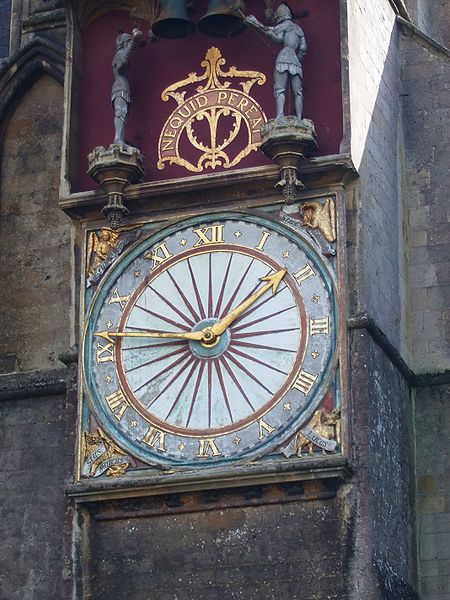
| WWT Shows | CLICK TO: Join and Support Internet Horology Club 185™ | IHC185™ Forums |

|
• Check Out Our... • • TWO Book Offer! • |
Welcome Aboard IHC185™  Internet Horology Club 185
Internet Horology Club 185  IHC185™ Discussion Site Main Page
IHC185™ Discussion Site Main Page  Horological Discussions, Questions and Answers
Horological Discussions, Questions and Answers  Pocket Watch Discussions
Pocket Watch Discussions  Roman Numerals
Roman Numerals
 Internet Horology Club 185
Internet Horology Club 185  IHC185™ Discussion Site Main Page
IHC185™ Discussion Site Main Page  Horological Discussions, Questions and Answers
Horological Discussions, Questions and Answers  Pocket Watch Discussions
Pocket Watch Discussions  Roman Numerals
Roman NumeralsGo  | New Topic  | Find-Or-Search  | Notify  | Tools  | Reply to Post  |  |
Does anyone know why the roman numeral IV is IIII on watch faces? | |||
|
| IHC Life Member |
Most likely back in the 1880s it was confusing just like today. So some smart guy said lets put 4 of these IIII on the dial. Back then six grade edumacation was standard. And yes I meant to spell it like that. | |||
|
| IHC Life Member |
I believe it has more to do with balance. The eight on the other side is VIII and it looks more balanced to have IIII for the four than IV. Don't forget a watch is as much a piece of art and jewelry as it is a timepiece. | |||
|
Roger,I believe you have the correct answer. | ||||
|
| IHC Life Member |
This 1396 vintage Wells Cathedral Clock indicates "IIII" instead if "IV" was an early habit with timepieces.  | |||
|
| IHC Vice President Pitfalls Moderator IHC Life Member |
That's a nice example David. Why? I agree with Brian, Roger has the correct answer. It's all about dial aesthetics. Best Regards, Ed | |||
|
David do you want to sell that clock | ||||
|
Sure and I got a piece of land in the Yukon that never goes below 80F. | ||||
|
| IHC Member 1142 |
MAYBE IT WAS BECAUSE IV STOOD FOR THE ROMAN GOD JUPITER AND THEY DIDNT BELIEVE IT WAS RIGHT TO DIPLAY THAT ON A CLOCK | |||
|
| IHC Life Member |
Here are some suggestions as to the why's and whyfor's.... Wikipedia: "IIII" on clocks.... Clock faces that are labeled using Roman numerals conventionally show IIII for four o'clock and IX for nine o'clock, using the subtractive principle in one case and not the other. There are many suggested explanations for this: . Many clocks use IIII because that was the tradition established by the earliest surviving clock, the Wells Cathedral clock built between 1386 and 1392. It used IIII because that was the typical method used to denote 4 in contemporary manuscripts (as iiij or iiii). That clock had an asymmetrical 24-hour dial and used Arabic numerals for a minute dial and a moon dial, so theories depending on a symmetrical 12-hour clock face do not apply.[22] . Perhaps IV was avoided because IV represented the Roman god Jupiter, whose Latin name, IVPPITER, begins with IV. This suggestion has been attributed to Isaac Asimov.[23] . Louis XIV, king of France, who preferred IIII over IV, ordered his clockmakers to produce clocks with IIII and not IV, and thus it has remained.[24] . Using standard numerals, two sets of figures would be similar and therefore confusable by children and others unused to reading clockfaces: IV and VI are similar, as are IX and XI. As the first pair are upside down on the face, an additional level of confusion would be introduced—a confusion avoided by using IIII to provide a clear distinction from VI. . The four-character form IIII creates a visual symmetry with the VIII on the other side, which the two-character IV would not. . With IIII, the number of symbols on the clock totals twenty Is, four Vs, and four Xs,[25] so clock makers need only a single mold with a V, five Is, and an X in order to make the correct number of numerals for their clocks: VIIIIIX. This is cast four times for each clock and the twelve required numerals are separated: .V IIII IX .VI II IIX .VII III X .VIII I IX The IIX and one of the IXs are rotated 180° to form XI and XII. The alternative with IV uses seventeen Is, five Vs, and four Xs, requiring the clock maker to have several different molds. . Only the I symbol would be seen in the first four hours of the clock, the V symbol would only appear in the next four hours, and the X symbol only in the last four hours. This would add to the clock's radial symmetry. Regards, Jerry | |||
|
| Powered by Social Strata |
| Your request is being processed... |
|
©2002-2025 Internet Horology Club 185™ - Lindell V. Riddle President - All Rights Reserved Worldwide

